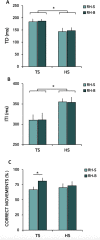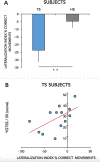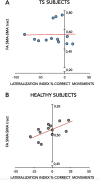Abnormal lateralization of fine motor actions in Tourette syndrome persists into adulthood
- PMID: 28708864
- PMCID: PMC5510833
- DOI: 10.1371/journal.pone.0180812
Abnormal lateralization of fine motor actions in Tourette syndrome persists into adulthood
Abstract
Youth with Tourette syndrome (TS) exhibit, compared to healthy, abnormal ability to lateralize digital sequential tasks. It is unknown whether this trait is related to inter-hemispheric connections, and whether it is preserved or lost in patients with TS persisting through adult life. We studied 13 adult TS patients and 15 age-matched healthy volunteers. All participants undertook: 1) a finger opposition task, performed with the right hand (RH) only or with both hands, using a sensor-engineered glove in synchrony with a metronome at 2 Hz; we calculated a lateralization index [(single RH-bimanual RH)/single RH X 100) for percentage of correct movements (%CORR); 2) MRI-based diffusion tensor imaging and probabilistic tractography of inter-hemispheric corpus callosum (CC) connections between supplementary motor areas (SMA) and primary motor cortices (M1). We confirmed a significant increase in the %CORR in RH in the bimanual vs. single task in TS patients (p<0.001), coupled to an abnormal ability to lateralize finger movements (significantly lower lateralization index for %CORR in TS patients, p = 0.04). The %CORR lateralization index correlated positively with tic severity measured with the Yale Global Tic Severity Scale (R = 0.55;p = 0.04). We detected a significantly higher fractional anisotropy (FA) in both the M1-M1 (p = 0.036) and the SMA-SMA (p = 0.018) callosal fibre tracts in TS patients. In healthy subjects, the %CORR lateralization index correlated positively with fractional anisotropy of SMA-SMA fibre tracts (R = 0.63, p = 0.02); this correlation was not significant in TS patients. TS patients exhibited an abnormal ability to lateralize finger movements in sequential tasks, which increased in accuracy when the task was performed bimanually. This abnormality persists throughout different age periods and appears dissociated from the transcallosal connectivity of motor cortical regions. The altered interhemispheric transfer of motor abilities in TS may be the result of compensatory processes linked to self-regulation of motor control.
Conflict of interest statement
Figures





References
-
- Ganos C, Martino D. Tics and Tourette syndrome. Neurol Clin 2015; 33:115–136. doi: 10.1016/j.ncl.2014.09.008 - DOI - PubMed
-
- Mataix-Cols D, Isomura K, Pérez-Vigil A, Chang Z, Rück C, Larsson KJ, et al. Familial Risks of Tourette Syndrome and Chronic Tic Disorders. A Population-Based Cohort Study. JAMA Psychiatry 2015; 72:787–793. doi: 10.1001/jamapsychiatry.2015.0627 - DOI - PubMed
-
- Bloch MH, Sukhodolsky DG, Leckman JF, Schultz RT. Fine-motor skill deficits in childhood predict adulthood tic severity and global psychosocial functioning in Tourette's syndrome. J Child Psychol Psychiatry 2006; 47:551–559. doi: 10.1111/j.1469-7610.2005.01561.x - DOI - PubMed
-
- Avanzino L, Martino D, Bove M, De Grandis E, Tacchino A, Pelosin E, et al. Movement lateralization and bimanual coordination in children with Tourette syndrome. Mov Disord 2011; 26:2114–2118. doi: 10.1002/mds.23839 - DOI - PubMed
-
- Sisti HM, Geurts M, Gooijers J, Heitger MH, Caeyenberghs K, Beets IA, et al. Microstructural organization of corpus callosum projections to prefrontal cortex predicts bimanual motor learning. Learn Mem 2012; 19:351–357. doi: 10.1101/lm.026534.112 - DOI - PubMed
MeSH terms
LinkOut - more resources
Full Text Sources
Other Literature Sources
Medical

